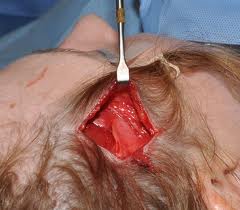
But migraine trigger point therapy is not always universally effective and some patients will have persistent pain. This has led to the identification of minor peripheral trigger points such as the lesser occipital and the auriculotemporal nerves. The auriculotemporal nerve is particularly interesting because it is near the site of temporal-based migraines. Most patients with this trigger point will press directly over a skin area between the eyebrow and the temporal hairline, the exact location of the coursing of the zygomaticotemporal nerve. But decompression of this nerve does not always relieve the migraines. The close association of the auriculotemporal nerve in the more posterior hair-bearing temporal scalp raises the question of its contribution to migraine pain.
In the August 2012 issue of Plastic and Reconstructive Surgery, a study entitled ‘The Auriculotemporal Nerve in Etiology of Migraine Headaches: Compression Points and Anatomical Variations’ was published. From an anatomical study out of Cleveland (the home of modern-day migraine surgery), a cadaver study was done to evaluate the course of the auriculotemporal nerve and to locate potential compression points along its course. Their studies showed three potential compression points; two located above the ear due to fascial bands and a third point due to being wrapped into and overlaid by the superficial temporal artery.
Having done a fair amount of surgery in the temporal region (temporal implants, temporal artery ligation, facelifts) I have always been impressed with the intricate anatomy and pathways of the arteries, veins and nerves in this area. For most of the traditional surgeries performed in this area, these neurovascular structures are a nuisance and are merely pushed to the side and/or tied off. But from a migraine standpoint, these anatomy could well be the source of a syndrome known as auriculotemporal neuralgia. This is a well known neurologic entity in which the patient experiences attacks of pain in the preauricular area that spreads upward to the temples.

Dr. Barry Eppley
Indianapolis, Indiana


